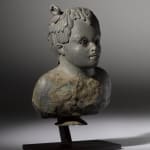Kajahl
152.4 x 121.9 cm
Further images
-
(View a larger image of thumbnail 1
)

-
(View a larger image of thumbnail 2
)

-
(View a larger image of thumbnail 3
)

-
(View a larger image of thumbnail 4
)

-
(View a larger image of thumbnail 5
)

-
(View a larger image of thumbnail 6
)

-
(View a larger image of thumbnail 7
)

-
(View a larger image of thumbnail 8
)

The word amphibian is derived from the Ancient Greek term (amphíbios),
which means 'both kinds of life', meaning 'of both kinds' and meaning 'life'.
The term was initially used as a general adjective for creatures that could
live on land or in water. This scene depicts a rare glimpse of a Coral Kid
Amphibian, coming up for a breath of air. Before descending back down
into the depths, an encounter with this elusive and unidentifiable
character gives rise to wonder about the nature of this cryptic scene.
Towering above the surface, head in the clouds, bolster the
monumentality of this moment. Far into the distance, a mountain ridge
dots the horizon.
The reddish earth tones of the figure's reflection are cast onto the
ultramarine blue surface, creating a beautiful contrast of color. His static
posture is combated by the gently churning tide as it engulfs the lower
portion of his body. At three-quarters view, the figure's somber
expression is unaware of being observed. The cornerstone of this
hybridized entity is a Greco-Roman, 1st-2nd century A.D. bronze
balsamarium in the form of an African boy. Bands of curly hair delicately
blend into a crowned headdress and angulating ribbed ponytail that is
derived from a bronze Benin sculpture. The red earthen terracotta-colored
torso with bulbous protuberances is derived from the Dijenne, (Mali)
civilization.







